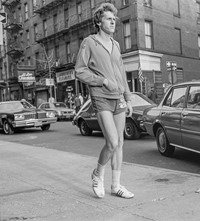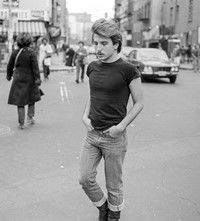Another Man previews a new book of the Indian photographer’s work, which captures Greenwich Village’s bustling LGBT scene
- TextDaisy Woodward
In 1976, Sunil Gupta, a young queer Indian student, arrived in New York City from his conservative hometown of New Delhi to begin an MBA in business. The city’s gay rights movement was in full swing in the aftermath of the Stonewall riots and in Greenwich Village a bustling LGBT scene had blossomed. For Gupta, the idea that a gay man such as himself could live openly, and as part of an empowered community, was a revelation. He was similarly blown away by the city’s art world – in particular its reverence for photography, a medium towards which he was inherently drawn.
Gupta promptly dropped his business studies, enrolling in photography classes at the New School instead. There, he was encouraged by his tutor, Lisette Model, to turn his lens to the streets. “The New Documents show at MoMA had been a big influence on everyone around me,” the photographer explains in Christopher Street, 1976, a compelling new book of his images from this time, published by Stanley/Barker. “Lisette talked about ‘Diane’ [Arbus] in class and the real life of the streets was our theatre.”
As the book’s title suggests, for Gupta one street appealed above all the rest – that at the very heart of New York’s gay sphere. “I hadn’t seen anything like it,” he recalls of his first encounter with Christopher Street in an interview with Tate. “This very public display of gay men, hundreds of them. You just stood on the corner and they were coming by every second.” The images Gupta took – beautifully captured in black and white, partly in homage to the likes of Arbus and Garry Winogrand, and partly because he had to develop them by hand in his bathroom – serve as a glorious time capsule of a bygone era, and sparked the esteemed photographer’s lifelong interest in documenting gay identity.
Men of all ages and ethnicities are snapped strolling, cycling and strutting down the road – alone, in groups and in pairs. Some make candid eye contact with Gupta, while others are engrossed in their own thoughts and conversations. The fashion is fabulously 70s: aviators, tight-fitting tees, double denim, plaid, leather and perfectly preened moustaches abound. But for Gupta, looking back, the images’ most important statement is their rountineness; their depiction of an “out and proud” community going about its daily business unhampered. “It was the heady days… before AIDS when we were young and busy creating a gay public space such as hadn’t really been seen before.”
Christopher Street, 1976 by Sunil Gupta is out now, published by Stanley/Barker.















